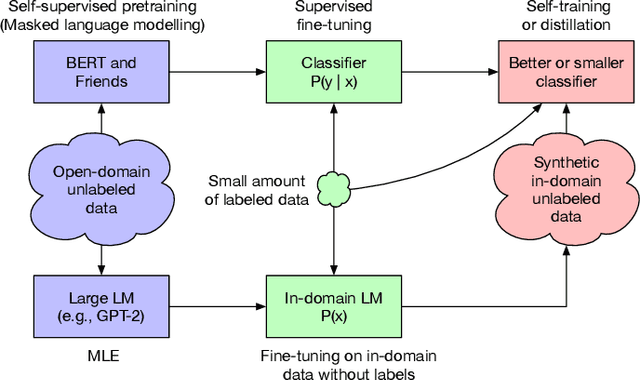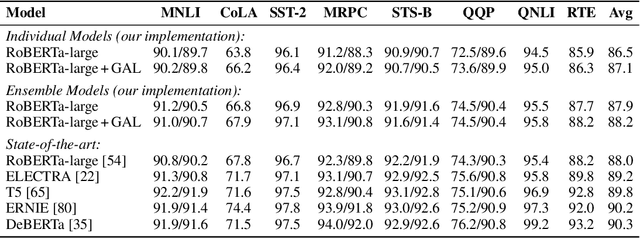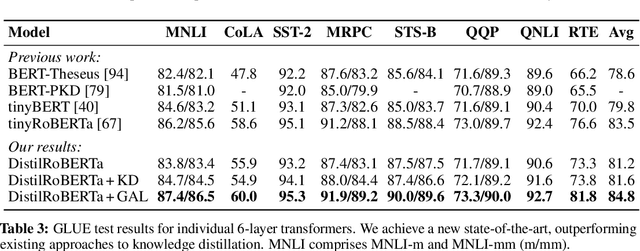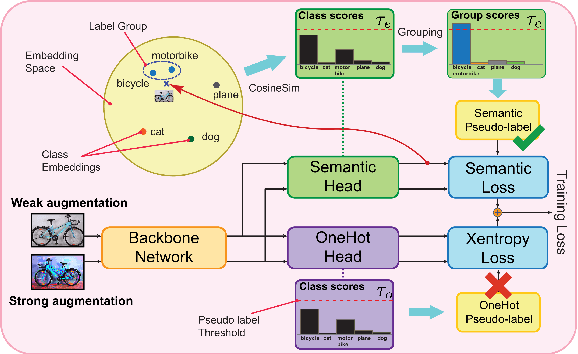Islam Nassar
ProtoCon: Pseudo-label Refinement via Online Clustering and Prototypical Consistency for Efficient Semi-supervised Learning
Mar 22, 2023



Abstract:Confidence-based pseudo-labeling is among the dominant approaches in semi-supervised learning (SSL). It relies on including high-confidence predictions made on unlabeled data as additional targets to train the model. We propose ProtoCon, a novel SSL method aimed at the less-explored label-scarce SSL where such methods usually underperform. ProtoCon refines the pseudo-labels by leveraging their nearest neighbours' information. The neighbours are identified as the training proceeds using an online clustering approach operating in an embedding space trained via a prototypical loss to encourage well-formed clusters. The online nature of ProtoCon allows it to utilise the label history of the entire dataset in one training cycle to refine labels in the following cycle without the need to store image embeddings. Hence, it can seamlessly scale to larger datasets at a low cost. Finally, ProtoCon addresses the poor training signal in the initial phase of training (due to fewer confident predictions) by introducing an auxiliary self-supervised loss. It delivers significant gains and faster convergence over state-of-the-art across 5 datasets, including CIFARs, ImageNet and DomainNet.
LAVA: Label-efficient Visual Learning and Adaptation
Oct 19, 2022



Abstract:We present LAVA, a simple yet effective method for multi-domain visual transfer learning with limited data. LAVA builds on a few recent innovations to enable adapting to partially labelled datasets with class and domain shifts. First, LAVA learns self-supervised visual representations on the source dataset and ground them using class label semantics to overcome transfer collapse problems associated with supervised pretraining. Secondly, LAVA maximises the gains from unlabelled target data via a novel method which uses multi-crop augmentations to obtain highly robust pseudo-labels. By combining these ingredients, LAVA achieves a new state-of-the-art on ImageNet semi-supervised protocol, as well as on 7 out of 10 datasets in multi-domain few-shot learning on the Meta-dataset. Code and models are made available.
Generate, Annotate, and Learn: Generative Models Advance Self-Training and Knowledge Distillation
Jun 11, 2021



Abstract:Semi-Supervised Learning (SSL) has seen success in many application domains, but this success often hinges on the availability of task-specific unlabeled data. Knowledge distillation (KD) has enabled compressing deep networks and ensembles, achieving the best results when distilling knowledge on fresh task-specific unlabeled examples. However, task-specific unlabeled data can be challenging to find. We present a general framework called "generate, annotate, and learn (GAL)" that uses unconditional generative models to synthesize in-domain unlabeled data, helping advance SSL and KD on different tasks. To obtain strong task-specific generative models, we adopt generic generative models, pretrained on open-domain data, and fine-tune them on inputs from specific tasks. Then, we use existing classifiers to annotate generated unlabeled examples with soft pseudo labels, which are used for additional training. When self-training is combined with samples generated from GPT2-large, fine-tuned on the inputs of each GLUE task, we outperform a strong RoBERTa-large baseline on the GLUE benchmark. Moreover, KD on GPT-2 samples yields a new state-of-the-art for 6-layer transformers on the GLUE leaderboard. Finally, self-training with GAL offers significant gains on image classification on CIFAR-10 and four tabular tasks from the UCI repository
All Labels Are Not Created Equal: Enhancing Semi-supervision via Label Grouping and Co-training
Apr 12, 2021



Abstract:Pseudo-labeling is a key component in semi-supervised learning (SSL). It relies on iteratively using the model to generate artificial labels for the unlabeled data to train against. A common property among its various methods is that they only rely on the model's prediction to make labeling decisions without considering any prior knowledge about the visual similarity among the classes. In this paper, we demonstrate that this degrades the quality of pseudo-labeling as it poorly represents visually similar classes in the pool of pseudo-labeled data. We propose SemCo, a method which leverages label semantics and co-training to address this problem. We train two classifiers with two different views of the class labels: one classifier uses the one-hot view of the labels and disregards any potential similarity among the classes, while the other uses a distributed view of the labels and groups potentially similar classes together. We then co-train the two classifiers to learn based on their disagreements. We show that our method achieves state-of-the-art performance across various SSL tasks including 5.6% accuracy improvement on Mini-ImageNet dataset with 1000 labeled examples. We also show that our method requires smaller batch size and fewer training iterations to reach its best performance. We make our code available at https://github.com/islam-nassar/semco.
 Add to Chrome
Add to Chrome Add to Firefox
Add to Firefox Add to Edge
Add to Edge